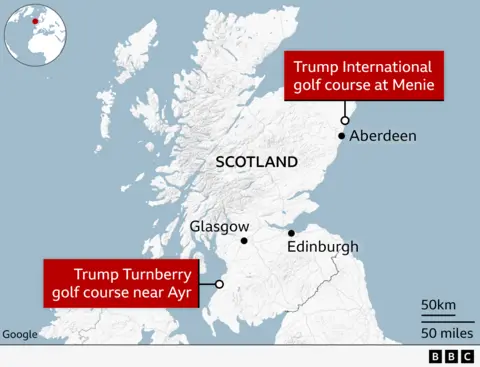In a monumental agreement that marks a significant shift in transatlantic trade relations, the United States and the European Union have concluded a trade deal that sets a 15% tariff on all EU goods imported to the US. This deal is the result of extensive negotiations between President Donald Trump and European Commission President Ursula von der Leyen, taking place at Trump’s Turnberry golf resort in Scotland. The newly agreed tariff represents a considerable reduction from the threatened 30% tariff that Trump had previously announced.
The agreement was a critical move to end the standoff that had frustrated both economies for months. As part of the deal, the EU has launched commitments to open its markets to US products, promising to implement zero percent tariffs on selected goods. This exchange reaffirms the interdependence of these two economic powerhouses, which together account for nearly one-third of global trade. Von der Leyen praised the arrangement as a stabilizing factor for both parties involved.
Trump’s broader strategy of imposing tariffs on major trading partners has been a cornerstone of his administration’s economic policy, aimed at reshaping global trade dynamics and reducing the US trade deficit. In recent years, Trump has negotiated similar tariff agreements with countries like the United Kingdom, Japan, Indonesia, the Philippines, and Vietnam, despite his ambitious goal of securing “90 deals in 90 days.” The tariff deal with the EU, according to some analysts, serves as both a victory for Trump and a strategic compromise for the EU.
However, opinions about the intricacies of the agreement are mixed across the Atlantic. French Minister for European Affairs, Benjamin Haddad, acknowledged certain positive aspects of the deal, particularly exemptions for key sectors like spirits. Still, he labeled the agreement as “unbalanced,” indicating concerns that the negotiations favored US interests disproportionately. Such sentiments highlight the contentious nature of trade negotiations, where economic advantages for one side often lead to apprehensions among the stakeholders on the other.
Details surrounding the negotiations have revealed that the agreement was reached after intensive talks on July 26. Following their meeting, Trump expressed confidence, referring to the deal as “something good for everybody,” while von der Leyen distinguished it as a “huge deal” that emerged from challenging discussions. She underscored the importance of the deal as a foundational agreement and emphasized the ongoing negotiations anticipated in the coming weeks regarding technical details.
The trade deal could potentially enhance US revenue significantly, with projected tariff collections reaching an estimated $90 billion based on previous trading statistics. Additionally, the agreement includes a solid commitment from the EU to invest around $600 billion in the US over the next three years in sectors that include military equipment and energy sources—efforts that, as von der Leyen notes, aim to lessen Europe’s dependency on Russian energy supplies.
One notable aspect of the deal is the inclusion of exemptions on particular goods, such as aircraft parts, certain agricultural products, and chemicals, while alcohol trade remains unresolved with debates surrounding tariff exemptions for French wines and Dutch beers ongoing. It is important to note that Trump intends to maintain the 50% tariff on steel and aluminum imports, adding layers of complexity to the overall trade relationship.
As this agreement unfolds, it will require further approval from the EU member states, which will discuss the implications during a meeting scheduled for the following weeks. European leaders have largely reacted with cautious optimism. For instance, Irish Prime Minister Micheál Martin highlighted the challenges posed by increased tariffs, and German Chancellor Friedrich Merz noted the risks of a trade conflict impacting Germany significantly.
With a significant backdrop of geopolitical considerations and larger implications for global trade dynamics, the deal between the US and the EU represents both an achievement for Trump’s administration and a measure of stability for European countries that are keen on maintaining favorable trade relations amidst ongoing uncertainties. As stakeholders analyze the deal’s ramifications, the continuing journey of trade negotiations continues to emphasize the intricate dance of diplomatically balancing national interests against collaborative international efforts.












